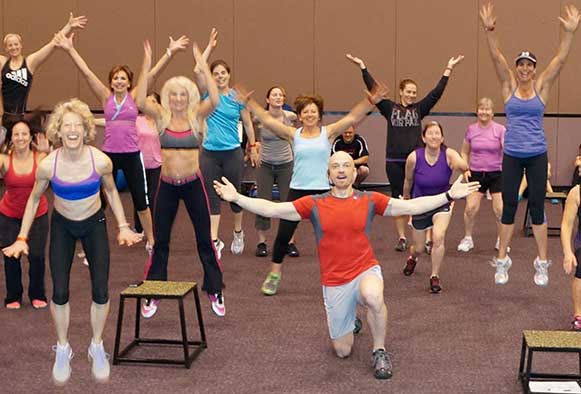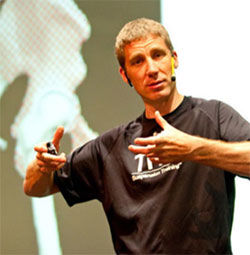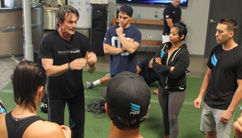
You’ve seen them on stage presenting at conferences around the country, sharing the latest findings in the field of health and fitness. You’ve gained practical skills from them during weekend workshops, learning how to safely and effectively teach group fitness classes, small-group training sessions and one-on-one workouts using cutting-edge equipment and training techniques. You’ve read their articles online, watched their videos and earned continuing education credits through their course offerings.
As a certified health and fitness professional, it’s safe to say that over the course of your career you’ve likely gained a wealth of knowledge and skills from various master trainers. And given your personal desire to continue to grow and evolve professionally in this field, you’ve likely considered becoming a master trainer yourself. You’re not alone. Each year, thousands of health and fitness professionals around the world express interest in making the transition from personal trainer to master trainer. The details of how to bring this evolution to fruition, however, often elude even the savviest health and fitness professionals. To thoroughly understand the steps to becoming a master trainer, it’s critical to begin by demystify the role that master trainers play in this ever-evolving industry.
The Many Roles of a Master Trainer
Jonathan Ross, senior consultant for the American Council on Exercise (ACE) and master trainer for ACE, SPRI and Tabata Bootcamp, believes that the overall objective of any master trainer should be to practically educate health and fitness professionals who are actively working in the field.
Clarifying Expectations
A common point of confusion among aspiring health and fitness professionals is the lack of understanding about the different layers that exist within the master trainer structure, which ranges from regional trainers who offer half-day, full-day and weekend-long workshops in their local areas, all the way to elite trainers who present shorter sessions and pre-conference workshops at higher-profile industry events around the world. While all of the trainers are delivering educational content on behalf of the brand, the manner in which they do so varies greatly. The same is true for the number of trainers who present at the conference level, which is typically a very small percentage of the larger pool of qualified, passionate master trainers. This is an important distinction to be aware of to ensure your expectations for becoming a master trainer are in line with the actual job responsibilities.
“Master trainers provide thought leadership in the fitness industry through the use of equipment and/or programs to provide a filter for much of what fitness professionals may be interested in, confused about or seeking clarity on how to best use with their clients or students.”
This education, which is presented on behalf of an organization or brand, is most commonly offered in the form of one- or two-day workshops averaging four to 16 hours. The role of a master trainer may also include leading educational sessions at conferences and events, developing innovative programming, creating educational content—including courses and accompanying training manuals—mentoring professionals on the inner workings of the fitness industry, serving as a brand ambassador on social media, and identifying and training other master trainers.
Additionally, depending on the exact structure of the company with which a master trainer is aligned, his or her responsibilities may also include handling the logistics of hosting the workshop, such as identifying a host site, printing training materials, collecting registrations, marketing the event and arranging travel to and from the course offering.
Examine Your Motivation
If the seemingly endless possibilities the role of master trainer provides piques your professional interest, the next step is to thoughtfully and honestly examine your underlying intentions for evolving your career. Many well-meaning health and fitness professionals fall victim to the false belief that after years of “working in the trenches”—that is, training clients and teaching classes—the next logical step is to become a trainer of trainers.
 Not necessarily, says Fraser Quelch, head of training for TRX.
Not necessarily, says Fraser Quelch, head of training for TRX.
“Becoming a master trainer should not be considered the next logical progression in your career just because you’ve spent years working in the field. The role of master trainer should be reserved for those individuals who are truly passionate about education and who understand and embody the art of teaching and inspiring others.”
In addition to this false perception, the allure of standing out from other professionals and being positioned front and center as an authority in the industry is frequently a driving force for many people, who covet the opportunity to potentially become the next big name in fitness.
Jodi Sussner, director of personal training and programming for Lift Brands, Inc. and master instructor for Mad Dogg Athletics, encourages those contemplating becoming a master trainer to really think about why they are seeking this specific role.
“If you are simply eager to feed your ego, check in with yourself,” suggests Sussner, who also offers education on behalf of Peak Pilates and UGI. “Give yourself plenty of time, not only to gain experience in the industry, but to gain perspective about yourself so that your message as a master trainer is clear and your teaching comes from a place of integrity and authenticity.”
 This advice is echoed by industry veteran Bill Sonnemaker, co-founder of Catalyst Fitness and master trainer for ACE, ViPR, IndoBoard and SURGE Performance Training, who began his work as a master trainer seven years ago based on a strong desire to raise the bar in the fitness industry.
This advice is echoed by industry veteran Bill Sonnemaker, co-founder of Catalyst Fitness and master trainer for ACE, ViPR, IndoBoard and SURGE Performance Training, who began his work as a master trainer seven years ago based on a strong desire to raise the bar in the fitness industry.
“I recommend only pursuing becoming a master trainer if giving back, helping others and working to ensure the industry is moving forward in the right direction is your passion. If your desire is just to make money, think again, as every top level master trainer that I know loses money once you break down how much time is spent preparing for, traveling to and teaching each course,” Sonnemaker explains. “At the end of the day, we do this work for the love of teaching and to know that we are leaving the industry better than how we found it.”
Understand the Application Process
If your intentions are pure and your desire to delivery high-quality education is truly what fuels your quest to become a master trainer, it’s important to begin familiarizing yourself with the required qualifications set forth by your targeted organization or brand. While the exact criteria varies from one organization to the next—for example, some organizations may mandate that a master trainer hold a master’s degree in an exercise science-related field while others may simply encourage an associate’s or bachelor’s degree—many share the same essential criteria for master trainers. These include:
- Current nationally recognized fitness certification (e.g., ACE, ACSM, NASM, NSCA)
- Ability to offer continuing education credits (CECs) for organizations such as ACE and AFAA
- A minimum of three to four years of experience actively working in the fitness industry
- A minimum of one to two years of presentation experience
- Successful completion of the course or training program you intend to offer
These qualifications, and many more, are specifically addressed in the majority of master trainer applications, many of which are available online, such as that offered by BOSU. Some organizations, however, opt instead to list the criteria required for master trainers on their website and then provide an email address for prospective master trainers to contact for more information, a process currently in practice by companies such as TRX and NETA. Additionally, some companies have elected not to publicly post information about the master trainer selection process, opting instead to proactively share those details directly with rising fitness professionals who have made their way onto the company’s radar.
Beyond the Basics
Formally applying to become a master trainer is obviously an important part of the process, especially for organizations that require a video submission and/or written test. However, simply meeting the mandatory criteria does not guarantee your place on a master trainer team. In addition to the qualifications listed above, many organizations rely heavily on other key qualities to effectively identify high-caliber individuals to deliver the company’s intellectual property and serve as influential brand ambassadors.
 Julz Arney, internationally recognized master trainer and program director for Shockwave and Indo-Row, shares that one of the most important qualities she seeks in a master trainer is an incredible desire and drive to educate others. “If an individual’s ambition is sincere, it will get the candidate through the often long and arduous process of joining the team of well-respected industry professionals. Beyond this, I look for someone who is an excellent communicator—meaning they can hold an audience’s attention for a 10-hour day or longer—and has a real passion for fitness and for people,” notes Arney, who formerly served as education director for Schwinn Cycling.
Julz Arney, internationally recognized master trainer and program director for Shockwave and Indo-Row, shares that one of the most important qualities she seeks in a master trainer is an incredible desire and drive to educate others. “If an individual’s ambition is sincere, it will get the candidate through the often long and arduous process of joining the team of well-respected industry professionals. Beyond this, I look for someone who is an excellent communicator—meaning they can hold an audience’s attention for a 10-hour day or longer—and has a real passion for fitness and for people,” notes Arney, who formerly served as education director for Schwinn Cycling.
Many organizations—including ACE, Schwinn and BOSU—specifically require a short video submission to view the applicant’s communication skills firsthand. Arney says that for Schwinn, the videos that prospective master trainers provide must be of a real indoor cycling class—not staged—to effectively demonstrate the individual’s ability to lead a workout experience.
“The workout we view needs to be exciting, expertly taught and right ‘on program’—or have great potential—in order to move a candidate further into the process.” To submit a video for feedback, individuals are expected to have a minimum of five years consistently teaching the given modality.
Anthony Wall, director of professional education for ACE, says that on top of a wealth of experience implementing various training techniques, prospective master trainers should also have at least several years of presentation experience, which isn’t limited to solely speaking at major industry conferences.
“Leading workshops at your local gym, recreation center and other community-based events are all great ways to bolster your presentation skills,” explains Wall.
Quelch adds that passionate, hardworking professionals often mistakenly assume that smaller-scale speaking engagements do not carry as much weight in the application process, which simply is not the case. “Any type of presentation experience is important, so if your desire is to become a master trainer, get out as much as possible and share your passion for education with others.”
 In addition to being a great speaker and having an unyielding desire to serve others by providing quality education and programming, master trainers must also be completely and authentically vested in the programs they offer, notes David Weck, creator of WeckMethod® and inventor of the BOSU Balance Trainer®.
In addition to being a great speaker and having an unyielding desire to serve others by providing quality education and programming, master trainers must also be completely and authentically vested in the programs they offer, notes David Weck, creator of WeckMethod® and inventor of the BOSU Balance Trainer®.
“Master trainers must truly believe in what they teach,” says Weck. “They must also believe that technique drives performance, and believe confidently that there is no one better to teach these specific techniques to others than them.”
From a business perspective, Shannon Fable, master trainer coordinator for Hedstrom Fitness, which includes fitness brands such as BOSU and Kamagon, notes that to truly succeed as a master trainer, individuals must be more than just great educators—they must also have an entrepreneurial spirit.
“In this competitive space, it’s important to respect that it’s a business,” explains Fable. “It’s critical to hone your business skills, which includes being responsive to emails, displaying knowledge of standard operating procedures and effectively marketing the brand.”
Make Yourself Known
To successfully make the transition to master trainer, it’s critical that you complete as much education as possible from the organization you aspire to work with to and learn their brand inside and out. However, you also need to actively put yourself out there in the industry in an effort to be noticed. Quelch shares that being persistent—yet professional—truly pays off, which TRX and ACE master trainer Shana Verstegen can personally attest to. After years of attending fitness conferences and specifically attending many sessions with Quelch himself, Verstegen decided to step outside of her comfort zone and approach him to inquire about how to become a part of the TRX brand.
“He was very helpful and explained that I needed to get as educated in TRX as possible by taking many courses, and that I also needed to establish a presence in the industry,” says Verstegen. “At first I feared I was in way over my head, but then I reminded myself how much I loved public speaking and teaching others.”
In our social media-driven world, it’s now easier than ever for fitness professionals to establish a presence in the industry and to effectively market their personal brands across a multitude of platforms, for little to no cost.
“If you’re not seen, you are not known,” notes Verstegen, who began her work as a master trainer in 2008. “Start a blog, post fitness videos on YouTube and perhaps earn a spot as the fitness expert on your local news station. These are all things companies will consider in the selection process.”
Another critical component that should not be overlooked is building a strong professional network. In fact, many of the most respected names in the world of health and fitness became master trainers as a result of referrals. In 1993, international fitness educator Keli Roberts was personally approached by Body Bar to develop programming and present at conferences on behalf of the organization; today, she continues to serve as a master trainer for the brand.
Master trainer Pete McCall can also attest to the power of networking. A number of years ago while living in Boston, one of his colleagues was working with ACE and offered a personal recommendation on his behalf when the organization was looking for additional trainers in the New England area.
“I was given the opportunity to become a master trainer for ACE without being required to audition,” says McCall. “In the education business, if the right person vouches for you and provides a personal reference, doors really begin to open and new opportunities are created, which is precisely what happened in my case. Shortly after that, ACE was hiring for a full-time position that I applied for, was offered and ultimately ended up moving to San Diego for to become an educator for the organization.”
For aspiring master trainers, fitness expert Chris Freytag recommends attending conferences and events to begin developing meaningful professional connections, something she credits with helping open doors for her to ultimately become a master trainer with SPRI.
“Make contacts and build relationships with other master trainers who can teach you, mentor you and give you advice,” Freytag urges.
Acknowledge the Advantages and the Challenges
Another important aspect of becoming a master trainer is to understand both the career advantages and challenges that come with such a coveted role. One great perk: a greatly expanded professional network, which helps to establish new connections and ultimately create new work opportunities.
 “Being a master trainer has led to additional opportunities for me,” shares Elizabeth Kovar, master trainer for ACE and BOSU, “such as writing articles, conducting media interviews and working as a master trainer for other organizations. Plus, my clients think its ‘cool’ that I train other trainers, and they now see me in a different light as an expert source.”
“Being a master trainer has led to additional opportunities for me,” shares Elizabeth Kovar, master trainer for ACE and BOSU, “such as writing articles, conducting media interviews and working as a master trainer for other organizations. Plus, my clients think its ‘cool’ that I train other trainers, and they now see me in a different light as an expert source.”
For ACE master trainer Julia Valentour, the role of master trainer has added great value to her professional resume, enabling her to explore additional career paths.
“Being a master trainer helped me to get in the door to teach at a small college,” explains Valentour. “I also feel like I am a much better instructor now because of the years of experience I’ve had teaching workshops.”
Most importantly, serving as a master trainer can also help individuals identify another way in which to grow and thrive in a field they are truly passionate about, doing the kind of work that they absolutely love. Stephanie Thielen, master trainer for AEA, NETA and BOSU shares that being a master trainer has not only helped her stay connected on a professional level, it’s also allowed her to truly live her purpose.
“Being a master trainer has allowed me to continue to do what I love to do, which is teach others to be personal trainers and group fitness instructors,” says Thielen. “While teaching weekly fitness classes keeps me connected to consumers, my real love is in working with up-and-coming fitness professionals.”
While doing what you love offers a wealth of benefits both personally and professionally, it’s not without its challenges. Scheduling and lack of time are two of the most common challenges cited by current master trainers like Roberts, who teaches on behalf of multiple organizations and brands, including Schwinn, BOSU, ACE, Indo-Row and Kamagon.
“Constant travel is very disruptive of a personal life, and always subbing classes or squeezing all of my clients into the beginning of the week so I can travel to present at events and lead workshops on the weekends can be really hard,” says Roberts.
Interacting with a wide variety of personalities, including those with strong opinions, can also prove challenging, shares Shannan Lynch, Ph.D., master trainer for Kettlebell Concepts. “When students want to contest or argue about a topic or theory, I respond by sharing openly with the group that fitness is a bit of a soft science, in that it’s not one-size-fits-all. The key to keeping a training on track is not to involve your own emotions, and to instead create a space for people to learn and grow while encouraging them to maintain an open mind for the duration of the course.”
Take the Next Step
Armed with words of wisdom from perhaps some of the very same master trainers who inspired you to consider this career path in the first place, take the wealth of information you have and begin putting it into action, says Claudia Micco, master trainer for YogaFit. “Study, learn, teach and reach, and stretch your mind in ways that are outside of the norm. Leave your ego at the door and always ensure that what you are doing is for the people that you teach—not for yourself.”
Bear in mind that as you forge ahead on this path you’re acknowledging that you are ready, willing and able to offer individuals more than just a great educational experience. After all, says Jenny Baldwin, master trainer and apprentice program coordinator for YogaFit, master trainers are not only great educators, but also amazing mentors, guides and resources. “A master trainer’s job doesn’t stop at the end of a training weekend, as he or she will continue to communicate with trainees as they move forward along their own personal paths.”
While the role of master trainer might seem like big shoes to fill, Ross suggests simply doing your best work each and every day, and to know that the more you do it and work on it, the better you’ll become at this craft of leading others. And, at the end of the day, this is more rewarding than you could ever imagine.





 by
by 

 Not necessarily, says Fraser Quelch, head of training for TRX.
Not necessarily, says Fraser Quelch, head of training for TRX.  This advice is echoed by industry veteran Bill Sonnemaker, co-founder of Catalyst Fitness and master trainer for ACE, ViPR, IndoBoard and SURGE Performance Training, who began his work as a master trainer seven years ago based on a strong desire to raise the bar in the fitness industry.
This advice is echoed by industry veteran Bill Sonnemaker, co-founder of Catalyst Fitness and master trainer for ACE, ViPR, IndoBoard and SURGE Performance Training, who began his work as a master trainer seven years ago based on a strong desire to raise the bar in the fitness industry.  Julz Arney, internationally recognized master trainer and program director for Shockwave and Indo-Row, shares that one of the most important qualities she seeks in a master trainer is an incredible desire and drive to educate others. “If an individual’s ambition is sincere, it will get the candidate through the often long and arduous process of joining the team of well-respected industry professionals. Beyond this, I look for someone who is an excellent communicator—meaning they can hold an audience’s attention for a 10-hour day or longer—and has a real passion for fitness and for people,” notes Arney, who formerly served as education director for Schwinn Cycling.
Julz Arney, internationally recognized master trainer and program director for Shockwave and Indo-Row, shares that one of the most important qualities she seeks in a master trainer is an incredible desire and drive to educate others. “If an individual’s ambition is sincere, it will get the candidate through the often long and arduous process of joining the team of well-respected industry professionals. Beyond this, I look for someone who is an excellent communicator—meaning they can hold an audience’s attention for a 10-hour day or longer—and has a real passion for fitness and for people,” notes Arney, who formerly served as education director for Schwinn Cycling. In addition to being a great speaker and having an unyielding desire to serve others by providing quality education and programming, master trainers must also be completely and authentically vested in the programs they offer, notes David Weck, creator of WeckMethod® and inventor of the BOSU Balance Trainer®.
In addition to being a great speaker and having an unyielding desire to serve others by providing quality education and programming, master trainers must also be completely and authentically vested in the programs they offer, notes David Weck, creator of WeckMethod® and inventor of the BOSU Balance Trainer®.  “Being a master trainer has led to additional opportunities for me,” shares Elizabeth Kovar, master trainer for ACE and BOSU, “such as writing articles, conducting media interviews and working as a master trainer for other organizations. Plus, my clients think its ‘cool’ that I train other trainers, and they now see me in a different light as an expert source.”
“Being a master trainer has led to additional opportunities for me,” shares Elizabeth Kovar, master trainer for ACE and BOSU, “such as writing articles, conducting media interviews and working as a master trainer for other organizations. Plus, my clients think its ‘cool’ that I train other trainers, and they now see me in a different light as an expert source.”
